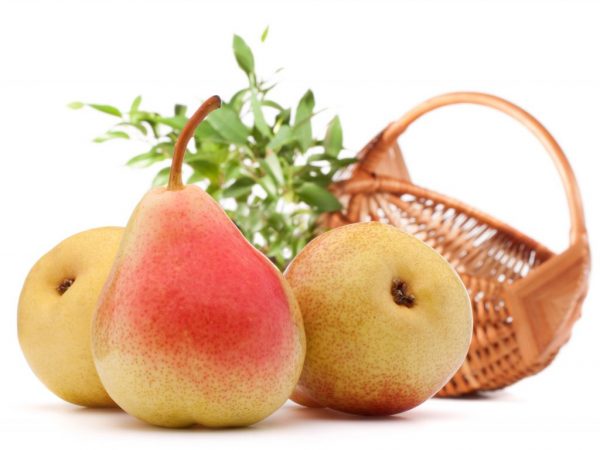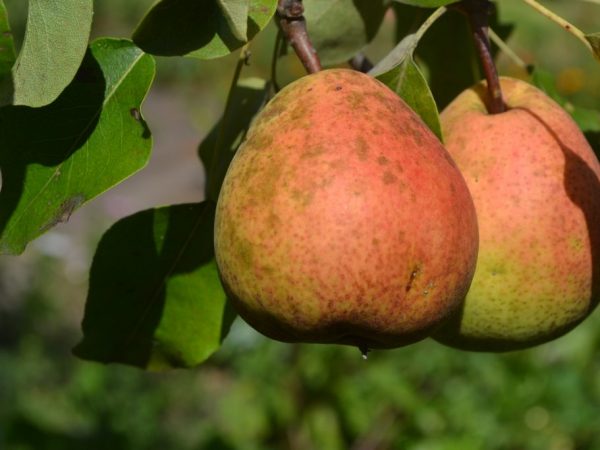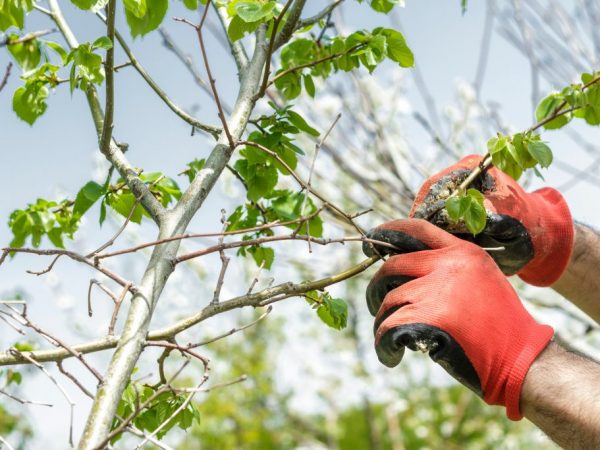Description of red-sided pear
Pear Red-sided is unpretentious in care and is distinguished by the quality of the crop. In the article, we will consider in detail the description of the variety.

Description of red-sided pear
Variety characteristic
The Krasnobokaya variety was bred specifically for the cold regions of Russia and, I must say, the selectors coped with their task perfectly - the culture they created is very frost-resistant, not whimsical, does not require abundant watering and at the same time brings a stable rich harvest.
Description of the tree
Characteristics of the tree: Trees of this species grow up to 4 m in height. The branches are not too dense, but spreading. The bark is heavily flaky. Leaves are oblong with small teeth at the edges. The branches are uneven, thin.
The tree begins to bear fruit at 5-7 years of age. Until this time, the trunk is gaining growth and strength. It is during this period that the bulk of plant care falls - transplantation (if necessary), crown formation, etc.
Description of the fetus
The fruits of the Red-sided are a bit like Chinese lanterns - they are more round than oblong and, when ripe, acquire a pronounced reddish color. Their average weight is 120-160 grams. One tree can harvest 110 kg. The skin on the fruit is soft, the flesh is very juicy and oily. The taste is sweet, with a slight astringency.
Fruits begin to ripen in mid-September and are stored for 1-3 months. The variety is table, therefore the Red-sided pear is used in the process of making jams and preservation, or simply consumed raw. True, you should not freeze this variety - after defrosting, the pulp becomes watery and not very pleasant to the taste.

The fruits are red in color, their average weight is 120-160 grams.
Landing
The landing site should be protected from drafts, well lit and not closer than 4 m high fences, buildings and other trees. Also make sure there are pollinators within 10m. The varieties Myth, Powislaya or Severyanka are best suited for this.
The pit is harvested in the fall. A hole with a diameter of 70 cm and 1 meter deep is being dug. If the groundwater is close, then the bottom should be covered with large pebbles. The nutrient mixture (20-25 cm of fertile soil, mixed with river sand (approximately 15 kg), 20 kg of organic fertilizers (compost or humus) and 300 g of superphosphate) should be poured into the pit, but not tamped. Then the pit is closed with a waterproof film.
Care
Red-sided does not require special care. Timely watering, good fertilization, and proper pruning are all that an adult tree needs to thrive and bear fruit effectively. And a little prevention from disease.
Watering
One-year-old seedlings need regular watering - about once every 7-10 days, 10-15 liters of water each. Trees aged 2 to 4 years should be watered 2 times a month using 25-30 liters of water. But adult trees are not so whimsical - they need 4 watering per season, each 40-45 liters of water.
- The first is produced before flowering, it is designed to strengthen the buds.
- The second is right after the beginning of flowering, this will help to form good ovaries.
- The tree is watered for the third time in the middle of the season, if there is a drought outside, then the procedure should be repeated 2-3 times.
- The last watering is the most abundant (60 liters of water per 1m2), it helps to prepare the plant for wintering.
Fertilizer
The tree is fertilized every 3-4 years, in the fall (25-30 kg for an adult tree). Mineral fertilizers include superphosphate, potassium, calcium and saltpeter. From organic means - humus, compost, manure and urea.
Pruning
The main pruning is carried out in the first 4 years of the seedling's life. This is a crown-forming pruning (the crown should not be too thick and open), as well as pruning of excess branches during the main growth of the trunk. Further, in the spring-autumn period, only sanitary pruning of dry and excess branches is carried out. After the pruning procedure, the cut site should be treated with garden varnish, this will reduce the risk of contracting any disease.

For effective fruiting, the tree needs timely watering, good fertilization and proper pruning.
Diseases and pests
The culture rarely becomes infected with scab and does not get sick with pear gall mites. But there is a danger of contracting other diseases.
Black cancer
The first symptoms of this disease are black cracks all over the tree. The affected areas should be cleaned with a metal brush, and then rinsed with a 2% solution of copper sulfate and covered with garden varnish.
Moniliosis
White fungal spores and dark brown spots on the fruit are clear signs of moniliosis. You can fight this infection like this: before flowering, spray a pear with 1% Bordeaux liquid, after flowering - 0.5% copper oxychloride, and after 14 days - with 0.5% Nitrofen solution. Prevention of this disease is the removal of fallen leaves.
Hawthorn
When the leaves curl into a tube and dry, then they must be removed immediately, and in the spring the tree must be treated with Entobacterin and sprayed with some kind of strong-smelling liquid (for example, tobacco with laundry soap).
Winter fall
A disease such as winter fall is a serious enough problem for a plant. The description says that a sign of this trouble is sticky spider webs on almost all parts of the tree. It is necessary to deal with this with the help of 0.3% Entobacterin, 2% Nitrofen and 4% N30 (treatment is carried out with each of these drugs with an interval of 2 weeks). Disease prevention is a mandatory digging of the soil in the fall.
Conclusion
The Krasnobokaya variety is a winter variety with an excellent characteristic: it is frost-hardy, unpretentious and has a high yield. It is perfect for both amateur summer residents and sophisticated gardeners.


